Driving To Alaska - part 1
In doing research for my Alaska road trip I got a lot of information from both freinds and the Internet.
I discovered several websites that were devoted to driving the lengthy Alaska Highway through Canada. Some of these involved stories of a personal nature, while others were a bit more formal and systematic. From these I learned about the individual routes one might take through Canada towards Alaska, plus the scenes and conditions I might encounter. Most web accounts made it seem like a journey up North would be no big deal, providing your were cautious and well-prepared.
Details gathered from personal friends and acquaintances were a bit more worrisome. I can only conclude (after the fact) that the information they gave me was somewhat out-of-date. Mostly there were descriptions of long sections of unpaved roads, where loose chat would destroy your headlights and windsheild. Road conditions would also play havoc on your tires and ding up the car body. The individuals reporting these facts to me often asked if a drive to Alaska was something I was certain I wanted to attempt.
Friends also told me about how the changes in seasonal temperature cause the ground beneath the highway to swell and contract, leaving the surface of the road broken and distorted. There was some truth to this, I discovered. The same folks said I should be prepared to entertain myself for long periods, because I might be the only car on the highway for hours at a time.
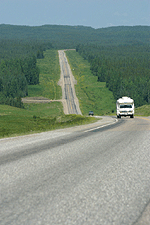
Well, I have to say that overall, my jaunt through the Northern wilderness was quite pleasant and uneventful. There were some surprises, but these had mostly to do with my expectations.
Upon entering Canada on Interstate 29, above Fargo, ND, I had no problem getting in. I simply showed the official my passport and told him the purpose of my trip. He asked me some typical questions about whether I was transporting any unauthorized items, or if I would be returning with any Canadian purchases. Evidently satisfied, they let me pass on through into Manitoba. Of course, I do suspect that I and my vehicle were covertly scrutinized through the use of cameras, detectors and information technology. If so, it was a painless experience.
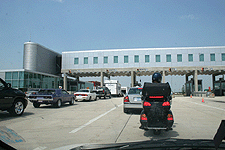
The next hurdle to get over was money. Having never left the United States before, I had no idea how dealing with foreign currency would work out. Immediately after passing through border security, I came upon the Manitoba welcome center. Here, I was greeted by several cheerful and attractive ladies, who proceeded to orient me to their country. They provided me with volumes of helpful literature and directed me towards the currency exchange booth.
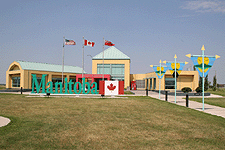
Again, the lady at the currency booth was quite charming and astute. She neatly took my bland American cash and converted it into the equivilent amount of Canadian bills and coins. I do have to say that their money is quite beautiful. I guess I arrived in Canada at a good moment, because the exchange rate was almost even. This kept me from worrying about how much I was really spending as I went. And to my delight, they had the same basic denominations that we use here, with the exception of the single dollar, which is a coin, not a bill. It's called the "loonie". It has the picture of a loon on it.
My strategy for carrying money in Canada was to hedge my bets. I would keep about half my available funds in cash and leave the rest in my checking account, where I could access it with my ATM card. Although I was going to try to use my bank card as much as possible, it does have a history of not working at the most inconvenient of times. Therefore, I decided to be prudent. In fact, I wasn't sure if the card would work at all or if it would be accepted out in the wilderness. As it turned out, practically everyone was willing to take plastic. And transactions went through about 3 out of every 4 times. When I was declined, my pocketful of cash saved me.
My next challenge was to come to terms with finding fuel. One piece of advice I took to heart was to "treat every gas station like it's the last". This I did. Gas stations were few and far between, but came often enough to keep travelers from being in a state of panic. Sometimes, though, gas stations would be closed or had run out of fuel. This lead at times to a little anxiety. As I traveled, I stopped to fill up at virtually every gas station I came to, even if it only meant putting in two dollars.

It was hard to determine just how much I was spending on gas. Everything was sold by the liter. Gas prices tend to be higher in Canada, and I happened to be there when overall fuel prices were above normal. One filling station attendant commented that I was lucky to be driving a small economy car. He said that he had filled up a large RV earlier in the day for just under $400.
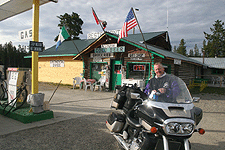
After traveling a few days, it became clear that I should fuel up right before I stopped for the night. I tended to depart extremely early in the morning, and service stations never seemed to open until around 9 or 10. While making my trip, I needed to cover as much distance as I could over the course of each day, at least 600 miles. I did this by staying on Central Standard Time as I passed through other time zones and by taking advantage of ever-increasing length of day.

I did find that I was unprepared for one aspect of Canadian gas purchasing. FULL SERVICE. Here in the US, we have grown accustomed to doing everything at the pump ourselves. No so in Canada. The moment I pulled into a Canadian gas station a perky young lad or friendly old gentleman would stroll over to my car and start filling it up. I was perplexed at first, but eventually adjusted.
Alright. Next I will mention the speed limit and distance conventions. Everything is in kilometers, and these basically line up with the speeds we expect to travel at in America. 55 mph is 90 kph. 70 mph is 110 kph. You just have to keep track of which guage on your speedometer you are using. Otherwise, everything else seems normal. As for distances, the numbers are much larger. Traffic signs tend to be very generic and some are in French.
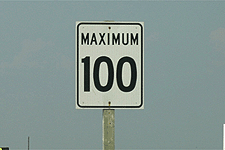
The next problem was in locating a place to stay. Now this is where reality most strayed from my expectations. Normally, as I cruise around the United States, I find there are small, inexpensive motels everywhere. I usually stay at a Days Inn, Super 8 or Motel 6. Those kinds of places. And I pretty much assumed the same would be true for the Canadian towns I was going to pass through. Uh-uh. There was a reason the girl at the Manitoba welcome center wanted to know if I was interested in camping, and subsequently handed me a thick directory. Motels were practically non-existent. At least down the roads I went on. There was the occasional lodge, but these were scarce.
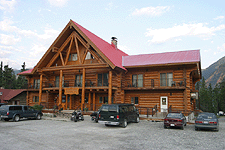
What I did encounter were an abundance of Provincial parks and RV campgrounds. If I had not had the foresight to bring along a tent, I would have been forced to sleep in my car. I only happened to take my camping equipment on a whim, so I was really lucky. As it turned out, I had no choice but to camp out the whole time I was in Canada. The good news is that it was cheap. Between $12 and $20 per night. With showers and electricity.

Actually, the electricity part was pretty funny. On a trip like this, I was taking digital pictures fast and furious and needed to download them at the end of every day. I happened to have my computer with me, just for this purpose, and it was amusing to see the wires running out of my car window, attached to an RV electrical pole.
Finally, I will mention food. This, too was hard to come by. Good food only was available when I passed through a Provincial capitol, like Edmonton, Alberta. About once a day, I encountered a rural town large enough to support a fast food restaurant or two. Mostly, however, the meals I downed came from grocery stores and gas stations. One day, I could find nothing but potato chips to eat. It was rather pathetic.
OK, that's it for now. Next time, more on driving through Canada and Alaska itself.
I discovered several websites that were devoted to driving the lengthy Alaska Highway through Canada. Some of these involved stories of a personal nature, while others were a bit more formal and systematic. From these I learned about the individual routes one might take through Canada towards Alaska, plus the scenes and conditions I might encounter. Most web accounts made it seem like a journey up North would be no big deal, providing your were cautious and well-prepared.
Details gathered from personal friends and acquaintances were a bit more worrisome. I can only conclude (after the fact) that the information they gave me was somewhat out-of-date. Mostly there were descriptions of long sections of unpaved roads, where loose chat would destroy your headlights and windsheild. Road conditions would also play havoc on your tires and ding up the car body. The individuals reporting these facts to me often asked if a drive to Alaska was something I was certain I wanted to attempt.
Friends also told me about how the changes in seasonal temperature cause the ground beneath the highway to swell and contract, leaving the surface of the road broken and distorted. There was some truth to this, I discovered. The same folks said I should be prepared to entertain myself for long periods, because I might be the only car on the highway for hours at a time.

Well, I have to say that overall, my jaunt through the Northern wilderness was quite pleasant and uneventful. There were some surprises, but these had mostly to do with my expectations.
Upon entering Canada on Interstate 29, above Fargo, ND, I had no problem getting in. I simply showed the official my passport and told him the purpose of my trip. He asked me some typical questions about whether I was transporting any unauthorized items, or if I would be returning with any Canadian purchases. Evidently satisfied, they let me pass on through into Manitoba. Of course, I do suspect that I and my vehicle were covertly scrutinized through the use of cameras, detectors and information technology. If so, it was a painless experience.

The next hurdle to get over was money. Having never left the United States before, I had no idea how dealing with foreign currency would work out. Immediately after passing through border security, I came upon the Manitoba welcome center. Here, I was greeted by several cheerful and attractive ladies, who proceeded to orient me to their country. They provided me with volumes of helpful literature and directed me towards the currency exchange booth.

Again, the lady at the currency booth was quite charming and astute. She neatly took my bland American cash and converted it into the equivilent amount of Canadian bills and coins. I do have to say that their money is quite beautiful. I guess I arrived in Canada at a good moment, because the exchange rate was almost even. This kept me from worrying about how much I was really spending as I went. And to my delight, they had the same basic denominations that we use here, with the exception of the single dollar, which is a coin, not a bill. It's called the "loonie". It has the picture of a loon on it.
My strategy for carrying money in Canada was to hedge my bets. I would keep about half my available funds in cash and leave the rest in my checking account, where I could access it with my ATM card. Although I was going to try to use my bank card as much as possible, it does have a history of not working at the most inconvenient of times. Therefore, I decided to be prudent. In fact, I wasn't sure if the card would work at all or if it would be accepted out in the wilderness. As it turned out, practically everyone was willing to take plastic. And transactions went through about 3 out of every 4 times. When I was declined, my pocketful of cash saved me.
My next challenge was to come to terms with finding fuel. One piece of advice I took to heart was to "treat every gas station like it's the last". This I did. Gas stations were few and far between, but came often enough to keep travelers from being in a state of panic. Sometimes, though, gas stations would be closed or had run out of fuel. This lead at times to a little anxiety. As I traveled, I stopped to fill up at virtually every gas station I came to, even if it only meant putting in two dollars.

It was hard to determine just how much I was spending on gas. Everything was sold by the liter. Gas prices tend to be higher in Canada, and I happened to be there when overall fuel prices were above normal. One filling station attendant commented that I was lucky to be driving a small economy car. He said that he had filled up a large RV earlier in the day for just under $400.

After traveling a few days, it became clear that I should fuel up right before I stopped for the night. I tended to depart extremely early in the morning, and service stations never seemed to open until around 9 or 10. While making my trip, I needed to cover as much distance as I could over the course of each day, at least 600 miles. I did this by staying on Central Standard Time as I passed through other time zones and by taking advantage of ever-increasing length of day.

I did find that I was unprepared for one aspect of Canadian gas purchasing. FULL SERVICE. Here in the US, we have grown accustomed to doing everything at the pump ourselves. No so in Canada. The moment I pulled into a Canadian gas station a perky young lad or friendly old gentleman would stroll over to my car and start filling it up. I was perplexed at first, but eventually adjusted.
Alright. Next I will mention the speed limit and distance conventions. Everything is in kilometers, and these basically line up with the speeds we expect to travel at in America. 55 mph is 90 kph. 70 mph is 110 kph. You just have to keep track of which guage on your speedometer you are using. Otherwise, everything else seems normal. As for distances, the numbers are much larger. Traffic signs tend to be very generic and some are in French.

The next problem was in locating a place to stay. Now this is where reality most strayed from my expectations. Normally, as I cruise around the United States, I find there are small, inexpensive motels everywhere. I usually stay at a Days Inn, Super 8 or Motel 6. Those kinds of places. And I pretty much assumed the same would be true for the Canadian towns I was going to pass through. Uh-uh. There was a reason the girl at the Manitoba welcome center wanted to know if I was interested in camping, and subsequently handed me a thick directory. Motels were practically non-existent. At least down the roads I went on. There was the occasional lodge, but these were scarce.

What I did encounter were an abundance of Provincial parks and RV campgrounds. If I had not had the foresight to bring along a tent, I would have been forced to sleep in my car. I only happened to take my camping equipment on a whim, so I was really lucky. As it turned out, I had no choice but to camp out the whole time I was in Canada. The good news is that it was cheap. Between $12 and $20 per night. With showers and electricity.

Actually, the electricity part was pretty funny. On a trip like this, I was taking digital pictures fast and furious and needed to download them at the end of every day. I happened to have my computer with me, just for this purpose, and it was amusing to see the wires running out of my car window, attached to an RV electrical pole.
Finally, I will mention food. This, too was hard to come by. Good food only was available when I passed through a Provincial capitol, like Edmonton, Alberta. About once a day, I encountered a rural town large enough to support a fast food restaurant or two. Mostly, however, the meals I downed came from grocery stores and gas stations. One day, I could find nothing but potato chips to eat. It was rather pathetic.
OK, that's it for now. Next time, more on driving through Canada and Alaska itself.


0 Comments:
Post a Comment
<< Home